Caring for your garden at home can be a rewarding and enjoyable experience, and with a few simple steps, you can ensure that your plants thrive and flourish. Starting a garden doesn’t have to be complicated, and breaking it down into manageable tasks can help you ease into gardening at your own pace.
One important aspect of garden care is understanding the needs of your plants. Observing your yard throughout the day will help you determine which spots receive full sun or shade, providing valuable insight into the amount of sunlight your plants require.
Properly preparing the soil is also essential for healthy garden growth. By removing weeds and sod, testing the soil for necessary nutrients, and adding organic matter like compost, you’ll create the ideal environment for your plants to flourish.
When it comes to selecting plants, it’s important to choose ones that are adapted to your specific garden conditions. Consider factors such as climate, soil type, and sunlight availability. Easy-to-grow options for beginners include annuals like marigolds and zinnias, perennials like black-eyed Susans and daylilies, and vegetables like tomatoes and peppers.
Regular watering is crucial for the health and vitality of your garden. Water your plants regularly, especially during hot weather, and aim to water in the morning or evening to minimize evaporation. Mulching the soil not only helps retain moisture but also prevents weed growth, keeping your garden beds looking their best.
Maintaining your garden is key to its long-term success. Regular tasks such as pruning plants, deadheading spent flowers, and addressing pests and diseases naturally will ensure that your garden remains beautiful and thriving.
Whether you have an outdoor garden or prefer to cultivate plants indoors, understanding the basics of watering, fertilizing, pruning, and providing proper light is essential. With proper care and attention, you can create a vibrant and flourishing garden right in your own backyard.
- Understanding your plants’ specific needs, including sunlight requirements, is essential for successful garden care.
- Proper soil preparation, including removing weeds and testing the nutrient levels, creates the ideal environment for your plants to thrive.
- When selecting plants, consider climate, soil type, and sunlight conditions to ensure they are adapted to your garden.
- Regular watering, mulching, and maintenance tasks are crucial for the health and vitality of your garden.
- Whether you have an outdoor or indoor garden, it’s important to understand the basics of watering, fertilizing, pruning, and providing proper light for your plants.
Understanding the Needs of Your Plants for Successful Garden Care
Every plant has unique requirements when it comes to sunlight and soil conditions, so it’s essential to observe your yard and understand what your plants need to thrive. Some plants prefer full sun, while others thrive in partial shade. Take note of the areas in your garden that receive different amounts of sunlight throughout the day. This will help you determine the ideal spots to plant your flowers, herbs, or vegetables.
In addition to sunlight, soil conditions play a crucial role in the overall health of your plants. Conduct a soil test to determine its pH level and nutrient content. This will give you valuable insights into which amendments, like compost or fertilizer, may be necessary to create the best growing environment for your plants. Removing weeds and sod from your garden beds will also help provide a clean slate for your plants to grow.
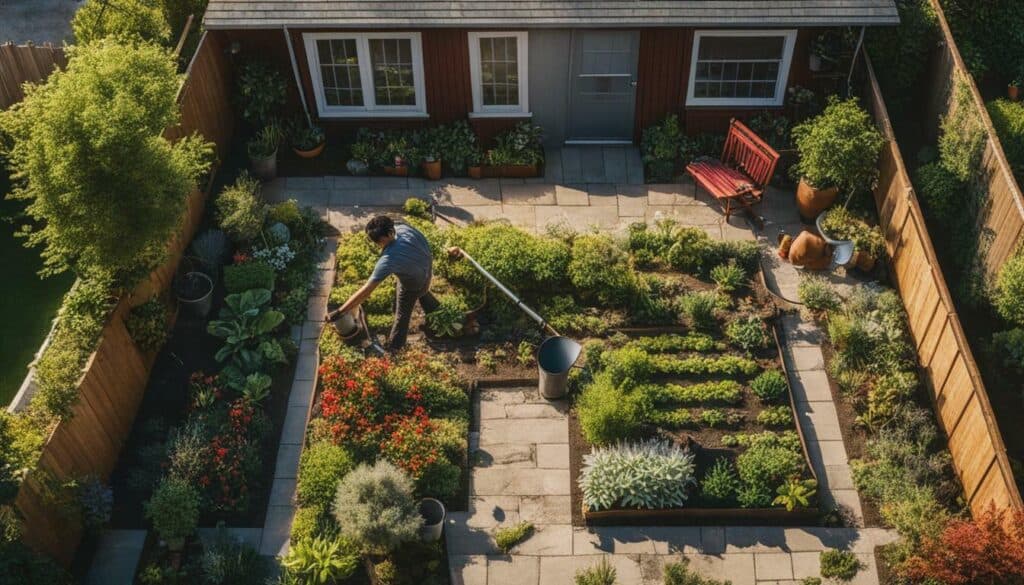
Once you have a good understanding of your plants’ light and soil requirements, you’ll be able to make informed decisions when selecting new additions for your garden. Consider factors such as your climate, the type of soil you have, and the amount of sunlight your garden receives. By choosing plants that are well-adapted to your specific conditions, you’ll increase their chances of thriving and minimize the need for constant intervention.
| Plant Type | Preferred Conditions |
|---|---|
| Marigolds | Full sun, well-drained soil |
| Black-eyed Susans | Full sun to partial shade, adaptable to various soil types |
| Tomatoes | Full sun, fertile and well-drained soil |
As you begin to care for your garden, remember that watering is a vital part of plant health. It’s important to provide your plants with regular, deep watering sessions to encourage deep root growth. Monitor your garden’s water needs, especially during hot weather, and adjust your watering schedule accordingly. Mulching the soil around your plants can help retain moisture, reduce weed growth, and regulate soil temperature.
By understanding the unique needs of your plants and providing them with the right care, your garden will thrive and reward you with beautiful blooms, delicious vegetables, and a tranquil outdoor space. Stay tuned for the next section where we’ll discuss the importance of preparing the soil for healthy garden growth.
Preparing the Soil for Healthy Garden Growth
A well-prepared soil is the foundation of a healthy garden, providing the essential nutrients and structure that your plants need to grow. To ensure your garden thrives, follow these simple steps to prepare your soil properly:
- Remove any weeds or sod that may hinder the growth of your plants. This will create a clean canvas for your garden.
- Test the soil to determine its nutrient levels. You can use a home testing kit or send a sample to a local agricultural extension office for analysis.
- Add organic matter to improve the soil’s fertility and structure. Compost, well-rotted manure, or leaf mold are excellent choices. Work these organic materials into the soil using a garden fork or tiller.
- Consider adding additional nutrients based on the results of your soil test. This could involve incorporating specific fertilizers or amendments to address any deficiencies.
By following these steps, you’ll create an ideal environment for your plants to thrive. A well-prepared soil will retain moisture, provide adequate drainage, and offer the necessary nutrients for healthy growth.
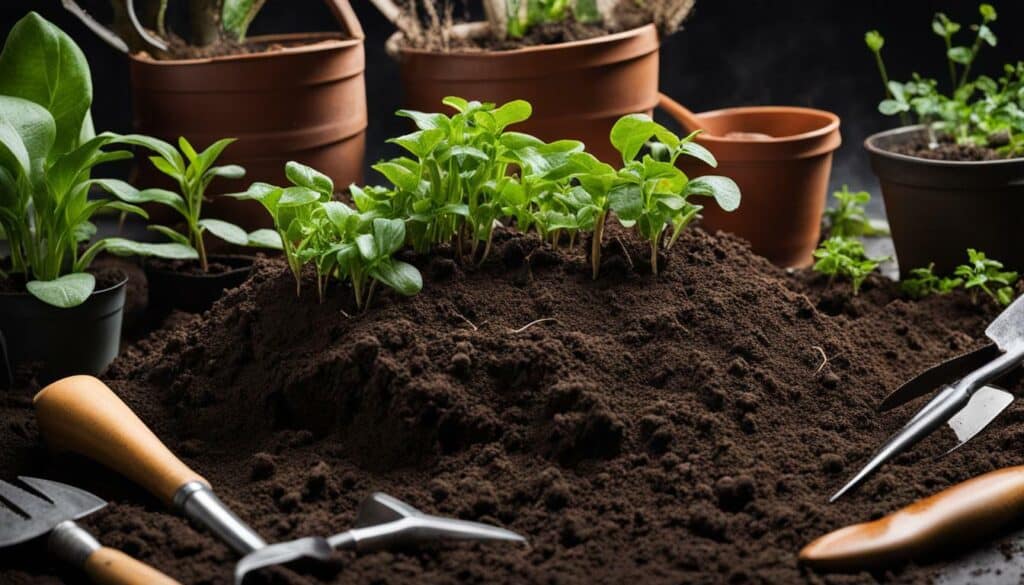
Selecting Plants Adapted to Your Garden’s Conditions
Selecting the appropriate plants for your garden will set you up for success in your gardening journey. When choosing plants, it’s important to consider factors like your climate, soil type, and sunlight conditions. By selecting plants that are well-suited to your garden’s specific conditions, you’ll increase the likelihood of their survival and growth.
Annuals, perennials, and vegetables are all great options for beginner gardeners. Annual plants like marigolds and zinnias provide vibrant color and are relatively low-maintenance. Perennials like black-eyed Susans and daylilies offer long-lasting beauty year after year. Vegetables like tomatoes and peppers can be a rewarding choice, providing fresh produce for your meals.
Before making your plant selections, take some time to observe your garden throughout the day. Notice which areas receive full sun, partial shade, or full shade. This will help you determine which plants will thrive in each area. For example, sun-loving plants like roses and sunflowers require at least six hours of direct sunlight each day, while shade-loving plants like hostas and ferns prefer less intense light.
In addition to considering sunlight requirements, be sure to choose plants that are adapted to your specific climate and soil conditions. Some plants are more tolerant of heat, cold, or drought, while others require specific soil pH levels or soil drainage. By understanding the needs of your plants, you can ensure the best chance of success in your garden.

| Plant Type | Examples |
|---|---|
| Annuals | Marigolds, Zinnias, Petunias |
| Perennials | Black-Eyed Susans, Daylilies, Coneflowers |
| Vegetables | Tomatoes, Peppers, Lettuce |
These plants are known for their resilience and ability to adapt to a variety of growing conditions. They require minimal care and are a great starting point for beginner gardeners. Keep in mind that even easy-to-grow plants require proper watering, fertilizing, and general maintenance to thrive.
By taking the time to choose plants that are well-suited to your garden’s conditions, you’ll be on your way to creating a beautiful and thriving garden. Remember to consider factors like sunlight, climate, and soil type when making your selections. Happy gardening!
Essential Watering Techniques for Healthy Plants
Water is a lifeline for your garden, and proper watering techniques are essential to keep your plants healthy and thriving. Whether you’re a beginner or an experienced gardener, understanding the right way to water your plants can make a big difference in their overall well-being. Here are some home gardening tips to help you master the art of watering:
1. Find the Right Balance
When it comes to watering your plants, finding the right balance is key. Overwatering can lead to root rot and other fungal diseases, while underwatering can cause stress and stunted growth. The goal is to provide enough moisture to keep the soil consistently damp but not soggy. To determine when it’s time to water, stick your finger about an inch into the soil. If it feels dry, it’s time to water. If it feels moist, hold off for a day or two. Remember, each plant has different water needs, so it’s important to observe and adjust accordingly.
2. Water at the Right Time
The timing of your watering is just as important as the amount. Watering in the early morning or late evening is ideal because it allows the water to penetrate deeply into the soil without quickly evaporating in the midday heat. Avoid watering during the hottest part of the day, as the water droplets can act like tiny magnifying glasses and scorch the leaves. By watering at the right time, you’ll maximize the absorption and minimize water waste.
3. Use the Right Technique
How you water your plants also matters. Instead of simply spraying the leaves, focus on delivering the water directly to the root zone. This can be done by using a watering can, a soaker hose, or drip irrigation. By watering at the base of the plant, you’ll ensure that the roots receive the moisture they need. Additionally, avoid wetting the foliage too much, as this can promote the growth of fungal diseases. If you do accidentally wet the leaves, make sure to water early in the day to allow them to dry before nighttime.
| Plant | Watering Frequency | Watering Amount |
|---|---|---|
| Herbs (e.g., basil, parsley) | When the top inch of soil is dry | Lightly moisten the soil |
| Vegetables (e.g., tomatoes, peppers) | When the top 2 inches of soil are dry | Aim for 1 inch of water per week |
| Perennials (e.g., daylilies, coneflowers) | When the top 3 inches of soil are dry | Deeply water to reach the roots |
Remember, these watering guidelines are just starting points. Factors like temperature, humidity, and soil type can affect the watering needs of your plants. It’s important to monitor your garden closely and make adjustments as necessary. With these home gardening tips, you’ll be well-equipped to provide your plants with the water they need to thrive. Happy gardening!
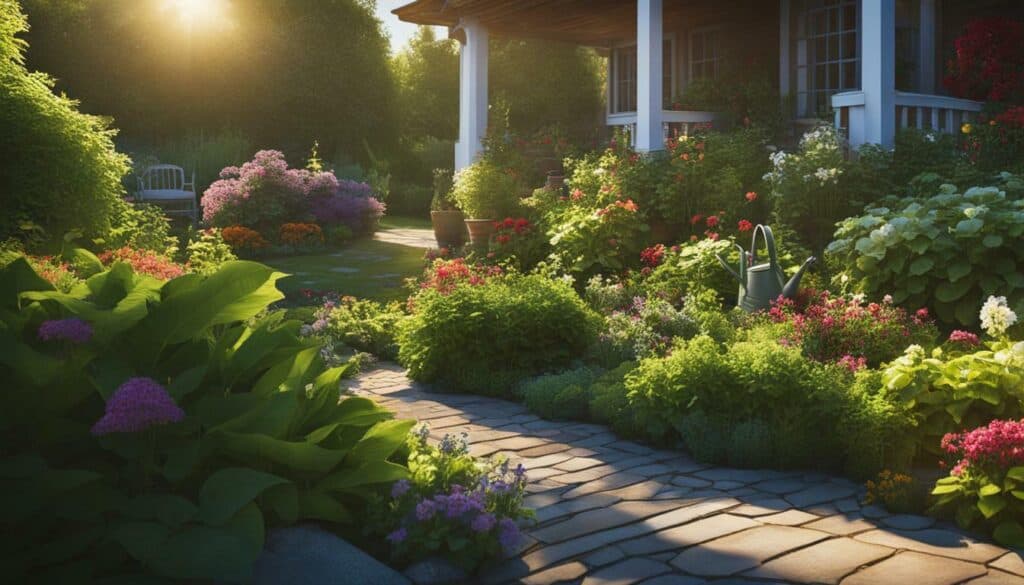
Mulching and weed prevention are essential tasks that will save you time and effort in the long run, while also benefiting the overall health and appearance of your garden. By understanding the importance of these practices and implementing them in your garden care routine, you can create a thriving and beautiful outdoor space.
One of the key benefits of mulching is its ability to retain moisture in the soil. By applying a layer of organic matter, such as wood chips or straw, around your plants, you can reduce water evaporation and keep the soil consistently moist. This is particularly important during hot summer months when water can quickly evaporate from the soil surface. Additionally, mulch acts as an insulating layer, protecting plant roots from extreme temperatures and fluctuations.
Another advantage of mulching is its ability to suppress weed growth. The mulch layer acts as a barrier, preventing sunlight from reaching weed seeds and inhibiting their germination. This reduces the need for manual weeding and minimizes competition between weeds and your garden plants for nutrients and water. As a result, your plants can thrive without the constant interference of unwanted vegetation.
In addition to these benefits, mulching also improves soil structure and fertility over time. As the mulch breaks down, it adds organic matter to the soil, improving its ability to retain water and nutrients. This creates a rich and fertile environment for your plants to grow and flourish.
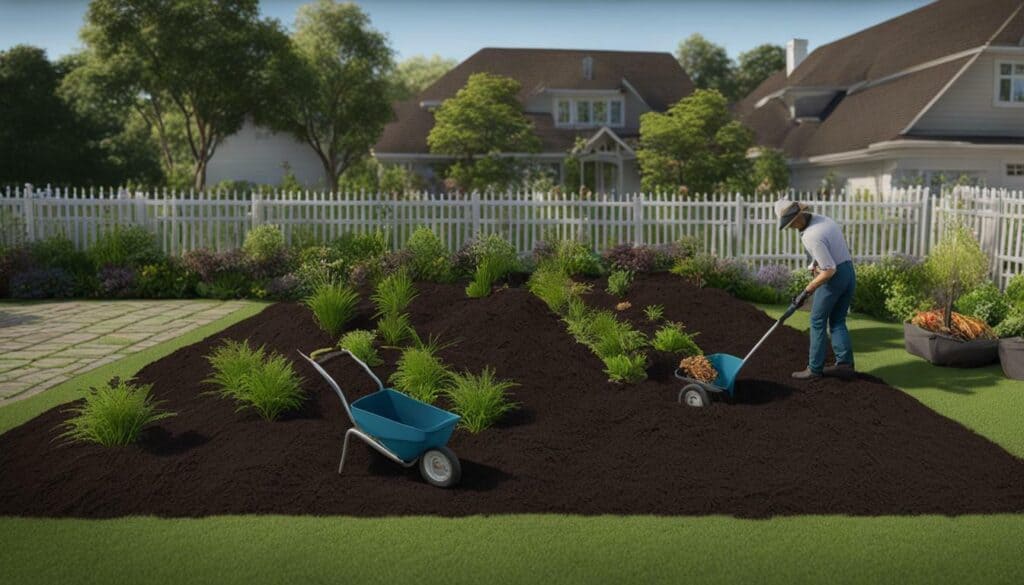
Incorporating mulching and weed prevention into your garden care routine is a simple and effective way to maintain a healthy and vibrant garden. By providing moisture retention, weed suppression, and improved soil fertility, mulching can greatly enhance the overall success of your plants. So go ahead, grab your gardening gloves and get started on creating a beautiful and thriving garden today!
Regular Maintenance for a Thriving Garden
Just like any other living thing, your garden requires regular care and attention to ensure it thrives and stays healthy. By incorporating a few simple maintenance tasks into your routine, you can enjoy a beautiful and flourishing garden at home. Let’s explore some essential steps to maintain the health and vitality of your garden.
Pruning and Deadheading
One important aspect of garden maintenance is pruning plants and deadheading spent flowers. Pruning helps maintain the shape and size of your plants, promotes new growth, and improves overall plant health. Deadheading, on the other hand, involves removing faded flowers to stimulate additional blooms. Both practices are essential for keeping your garden looking neat and tidy. Remember to use clean and sharp tools to prevent damage to the plants, and always prune and deadhead according to the specific requirements of each plant.
Pest and Disease Control
Another crucial aspect of garden care is addressing pest and disease issues. It’s important to regularly inspect your plants for signs of pests, such as aphids, snails, or caterpillars, and take appropriate measures to control them. Organic pest control methods, like using insecticidal soaps or introducing beneficial insects, are effective and environmentally friendly alternatives to chemical pesticides. Additionally, keeping your garden clean and free of debris can help prevent the spread of plant diseases. If you notice any signs of disease, promptly remove and dispose of infected plant parts to contain the problem.
Natural Weed Prevention
Weeds can quickly take over your garden if left unchecked. Regular weeding is essential to prevent weeds from competing with your plants for nutrients and water. To minimize weed growth, consider applying a layer of organic mulch, such as wood chips or straw, around your plants. Mulch helps suppress weed growth by blocking sunlight and conserving moisture in the soil. Additionally, using a hoe or hand weeding tool to remove weeds when they are small and before they have a chance to spread can make the task more manageable.
Keeping Your Garden Tidy
In addition to the specific maintenance tasks mentioned above, it’s important to keep your garden tidy and organized. Regularly remove any fallen leaves, debris, or spent plants to maintain a clean and aesthetically pleasing garden. This not only enhances the visual appeal but also helps prevent the development of pests and diseases. By dedicating a few minutes each day or week to tidying up your garden, you’ll create a welcoming space for your plants to thrive.
Remember, regular maintenance is key to the success of your garden. By incorporating these tasks into your gardening routine, you’ll be rewarded with a vibrant and flourishing garden that brings joy and beauty to your home.
Indoor Gardening Tips for Greenery Inside
Indoor gardening is a fantastic way to bring the beauty of nature inside your home, and with the right knowledge, you can create a thriving botanical oasis. Whether you have a spacious room or limited space, there are plenty of options for cultivating plants indoors. Here are some essential tips to help you get started with your indoor garden:
1. Choose the Right Plants
Not all plants thrive indoors, so it’s important to choose ones that are well-suited for indoor conditions. Look for plants that have low light requirements and can tolerate the lower humidity typically found indoors. Some popular choices include pothos, snake plants, and peace lilies. Don’t be afraid to experiment with different plants to find the ones that work best for your space.
2. Provide Adequate Light
Light is essential for photosynthesis, which is the process that plants use to convert light into energy. Most indoor plants require bright, indirect light to thrive. Place your plants near a window where they can receive natural light, but be sure to avoid direct sunlight, as it can scorch the leaves. If you don’t have access to natural light, you can use artificial grow lights to provide the necessary light spectrum for plant growth.
3. Water with Care
Proper watering is crucial for the health of your indoor plants. Overwatering can lead to root rot, while underwatering can cause your plants to wither and die. The key is to find a balance and water your plants when the top inch of soil feels dry to the touch. Be sure to drain any excess water from the saucer or pot to prevent waterlogged roots.
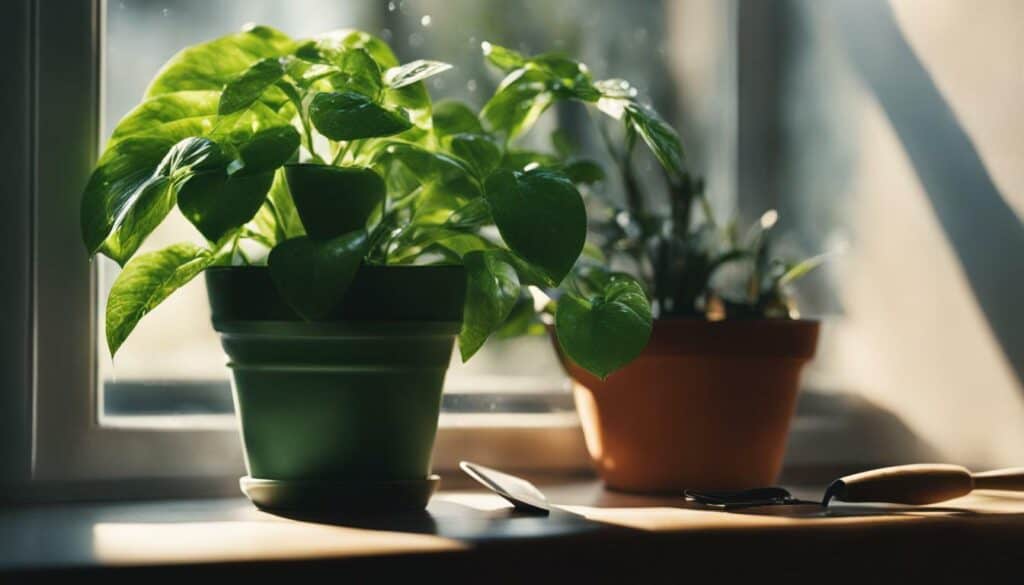
Indoor environments are often drier than what plants are accustomed to in their natural habitat. To create a more humid microclimate for your plants, you can group them together or place a tray of water near them. Another option is to use a humidifier to increase the moisture in the air.
Indoor gardening can be a fulfilling and rewarding hobby that brings beauty and nature into your home. With these tips, you’ll be well on your way to creating a lush indoor garden that will brighten up any space. So go ahead, get your hands dirty, and enjoy the joys of gardening indoors!
The Basics of Watering, Fertilizing, and Pruning
Understanding the basics of watering, fertilizing, and pruning is key to maintaining healthy and vibrant plants in your garden. Proper watering ensures that your plants receive the right amount of moisture, preventing both under and over-watering, which can lead to root rot or dehydration. To water effectively, consider the type of plants you have and their specific needs. Some plants, like succulents, prefer drier conditions, while others, like ferns, thrive in more humid environments.
When it comes to fertilizing, it’s important to provide your plants with the necessary nutrients for optimal growth. Organic fertilizers, such as compost or manure, are a popular choice as they enrich the soil without the use of harsh chemicals. Follow the instructions on the fertilizer packaging to determine the appropriate amount and frequency of application. Remember, it’s always best to start with a little less and gradually increase if needed.
Pruning is an essential practice for maintaining the shape and health of your plants. By removing dead or damaged branches, you encourage new growth and prevent diseases from spreading. Additionally, pruning helps to control the size of your plants and improve their overall appearance. Make sure to use clean and sharp pruning tools to minimize damage to the plant, and always prune during the appropriate season for each specific plant.
| Watering Tips | Fertilizing Tips | Pruning Tips |
|---|---|---|
|
|
|
By mastering the basics of watering, fertilizing, and pruning, you’ll be well on your way to providing optimal care for your garden. Remember, each plant has unique needs, so it’s important to research and understand the specific requirements of the plants in your garden. With a little attention and proper care, your garden will flourish and reward you with beautiful blooms and abundant harvests.
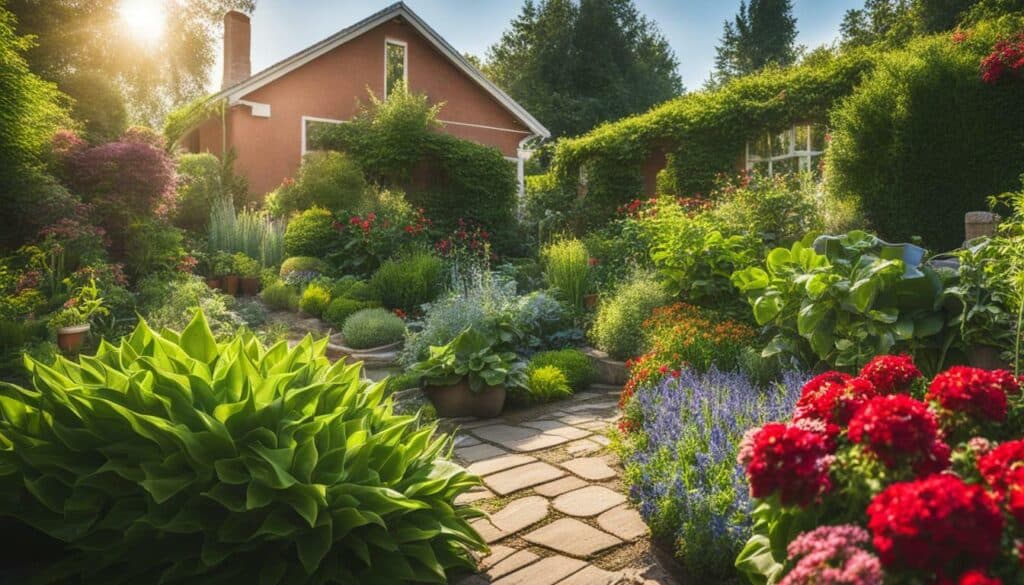
Just like humans, plants rely on sunlight for energy, so understanding their light requirements is essential for their growth and development. When it comes to gardening, providing proper light conditions for your plants can make all the difference. Different types of plants have varying light needs, so it’s important to assess your garden’s lighting conditions and choose the right plants accordingly.
One way to determine the light levels in your garden is to observe it throughout the day. Take note of which areas receive full sun, partial sun, or shade. Full sun refers to areas that receive at least six hours of direct sunlight each day, while partial sun areas receive around four to six hours. Shade areas, on the other hand, receive less than four hours of direct sunlight.
Once you have a clear understanding of your garden’s lighting conditions, you can select plants that thrive in those conditions. For areas with full sun, you can consider planting sun-loving plants like marigolds, zinnias, or roses. If you have partially shaded areas, shade-loving plants like hostas or ferns are great choices. And for completely shaded spots, plants like impatiens or begonias can add color and vibrancy to your garden.
Remember, the light needs of plants can vary, so it’s important to read the care instructions that come with each plant or research their specific requirements. Providing your plants with the right amount of light will ensure their overall health and vitality, allowing them to thrive in your garden.
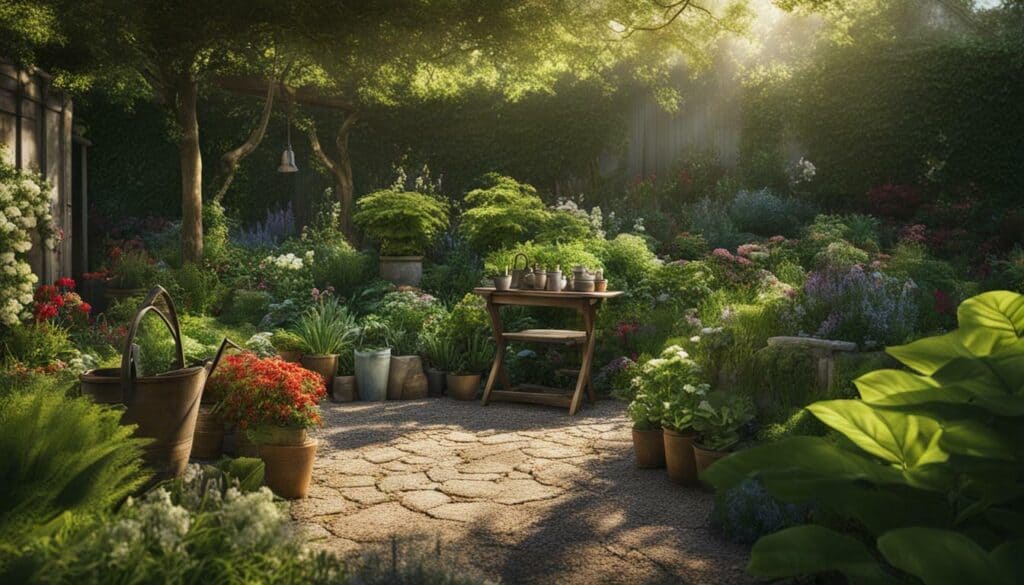
| Plant | Light Requirement |
|---|---|
| Roses | Full Sun |
| Marigolds | Full Sun |
| Zinnias | Full Sun |
| Hostas | Partial Shade |
| Ferns | Partial Shade |
| Impatiens | Full Shade |
| Begonias | Full Shade |
A Thriving Garden Starts with Care and Attention
Caring for a garden is a continuous process that requires dedication and attention, but the rewards are well worth the effort. Whether you’re a beginner or have been gardening for years, there’s always something new to learn and discover in the world of plants. By following a few simple tips and techniques, you can create a thriving garden that brings beauty and tranquility to your home.
One of the most important aspects of garden care is understanding the needs of your plants. Each plant has its own specific requirements for sunlight, water, and nutrients. Observing your yard throughout the day will help you determine which spots receive full sun or shade, allowing you to choose the right plants for each area. Consider factors such as soil type and moisture levels when selecting plants, as these can greatly impact their growth and overall health.
To ensure your garden flourishes, it’s essential to prepare the soil properly. Start by removing weeds and sod, creating a clean and healthy environment for your plants to thrive. Testing the soil for nutrient levels is also crucial, as it helps you determine whether any amendments or fertilizers are needed. Adding organic matter, such as compost, enriches the soil and provides a source of essential nutrients for your plants.
| Easy-to-Grow Plants for Beginners | Light Requirements | Watering Needs |
|---|---|---|
| Marigolds | Full sun | Regular watering |
| Zinnias | Full sun | Regular watering |
| Black-eyed Susans | Full sun to partial shade | Regular watering |
| Daylilies | Full sun to partial shade | Regular watering |
| Tomatoes | Full sun | Regular watering |
| Peppers | Full sun | Regular watering |
(Table: Easy-to-Grow Plants for Beginners)
Watering your plants regularly is essential for their growth and survival. During hot weather, plants may require more frequent watering to prevent dehydration. It’s best to water your garden in the morning or evening to minimize evaporation and ensure that the water reaches the roots effectively. Mulching the soil around your plants helps retain moisture and suppresses weed growth, reducing the need for frequent watering and weeding.
Remember, gardening is not just about the end result—it’s about the journey. Enjoy the process, experiment with different plants and techniques, and don’t be afraid to ask for help or seek advice from fellow gardeners. With time and patience, your garden will reward you with beauty, tranquility, and a sense of accomplishment.
Providing Proper Light for Your Plants’ Needs
Light is one of the most critical factors for plant growth and development. Understanding the light requirements of your plants is essential to ensure their success. Some plants thrive in full sun, while others prefer partial shade. Assessing the light conditions in different areas of your garden will help you determine the best locations for specific plants. Consider using shade cloth or strategically placed shade structures to protect delicate plants from intense sunlight.
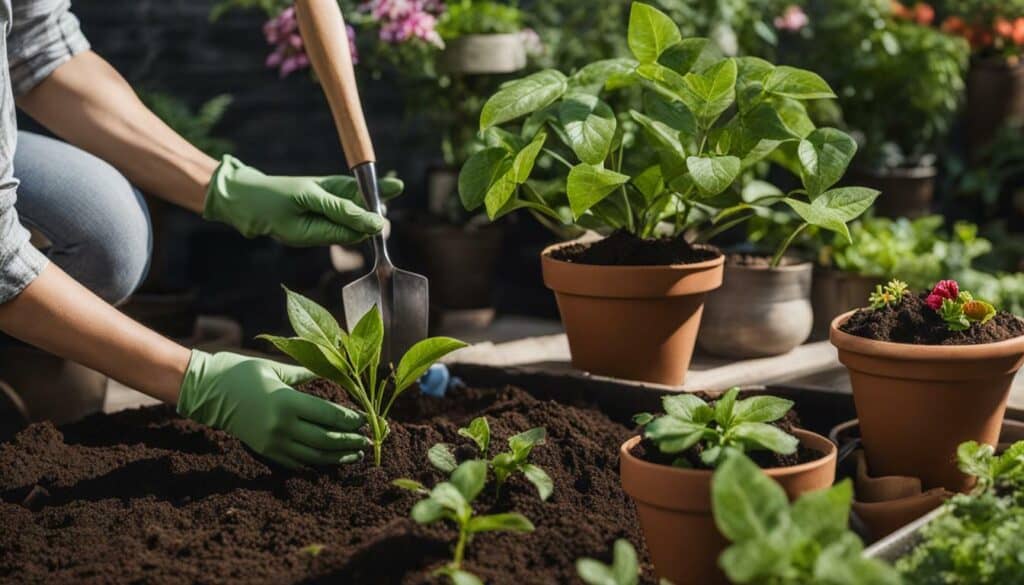
Creating and maintaining a thriving garden takes time and effort, but the joy and satisfaction it brings are unparalleled. From understanding your plants’ needs to providing proper care and attention, every step in the gardening process contributes to the growth and success of your garden. So, roll up your sleeves, get your hands dirty, and let your green thumb lead the way!
Conclusion
Creating and maintaining a garden at home is a journey filled with learning, growth, and the rewards of nurturing life. It doesn’t have to be complicated, and by breaking it down into manageable steps, you can ease into gardening at your own pace. One important aspect of garden care is understanding the needs of your plants, such as their sunlight requirements. By observing your yard throughout the day, you can determine the spots that receive full sun or shade, allowing you to choose the appropriate plants for each area.
Properly preparing the soil is also crucial for a healthy garden. By removing weeds and sod, testing the nutrient levels, and adding organic matter like compost, you can create the ideal environment for your plants to thrive. When it comes to selecting plants, it’s important to consider your climate, soil type, and sunlight conditions. There are many easy options for beginners, such as marigolds, zinnias, black-eyed Susans, daylilies, tomatoes, and peppers.
Regular watering is vital for the health and vitality of your garden, especially during hot weather. It’s best to water in the morning or evening to minimize evaporation. Mulching the soil not only helps retain moisture but also prevents weed growth, keeping your garden beds neat and tidy. Additionally, regular maintenance tasks like pruning plants, deadheading spent flowers, and addressing pests and diseases naturally are necessary to keep your garden looking its best.
Whether you’re gardening outdoors or indoors, understanding the basics of watering, fertilizing, pruning, and providing proper light is essential. With proper care and attention, your garden will flourish, providing you with beauty, fresh produce, and a sense of accomplishment. So, embrace the journey of garden care and enjoy the rewards of nurturing life right in your own backyard.
FAQ
Q: How do I determine the amount of sunlight my plants require?
A: Observing your yard throughout the day will help you determine which spots receive full sun or shade. This will give you an idea of the amount of sunlight your plants need.
Q: How do I prepare the soil for my garden?
A: To prepare the soil properly, start by getting rid of weeds and sod. Test the soil for its nutrient levels and add organic matter like compost to improve its fertility.
Q: How do I select the right plants for my garden?
A: Choose plants that are adapted to your climate, soil, and sunlight conditions. Easy options for beginners include annuals like marigolds and zinnias, perennials like black-eyed Susans and daylilies, and vegetables like tomatoes and peppers.
Q: When is the best time to water my plants?
A: It’s best to water your plants in the morning or evening to minimize evaporation. Regular watering is especially crucial in hot weather to ensure your plants stay hydrated.
Q: How can I retain moisture in the soil and prevent weed growth?
A: Mulching the soil can help retain moisture and prevent weed growth. Applying mulch to your garden beds is an effective way to achieve both these benefits.
Q: How do I maintain a thriving garden?
A: Regular maintenance tasks include pruning plants, deadheading spent flowers, and addressing pests and diseases naturally. These practices will keep your garden healthy and flourishing.
Q: What are some indoor gardening tips?
A: For indoor gardening, ensure your plants receive proper lighting, water them appropriately, and fertilize them as needed. These practices will help you create a green oasis indoors.
Q: What are the basics of watering, fertilizing, and pruning?
A: Proper watering involves providing enough moisture without overwatering, while fertilizing should be done according to your plants’ needs. Pruning helps maintain their shape and remove dead or diseased parts.
Q: How important is proper lighting for my plants?
A: Proper lighting is crucial for photosynthesis and the overall well-being of your plants. Assessing light levels and choosing the best locations for your plants’ light requirements is essential.
Q: What is the key to a thriving garden at home?
A: The key to a thriving garden is care and attention. Understanding your plants’ needs, choosing the right plants, and providing consistent care will help you create a beautiful and flourishing garden at home.
Can I Apply the Same Techniques for Home Garden Care in Maintaining Gardens?
Maintaining a home garden requires time, effort, and knowledge. However, with the right techniques, garden maintenance made simple. Applying these techniques consistently can help in keeping your garden vibrant and healthy. Whether it’s watering, weeding, or pruning, understanding the needs of your plants and implementing proper care can ensure a flourishing garden all year round.

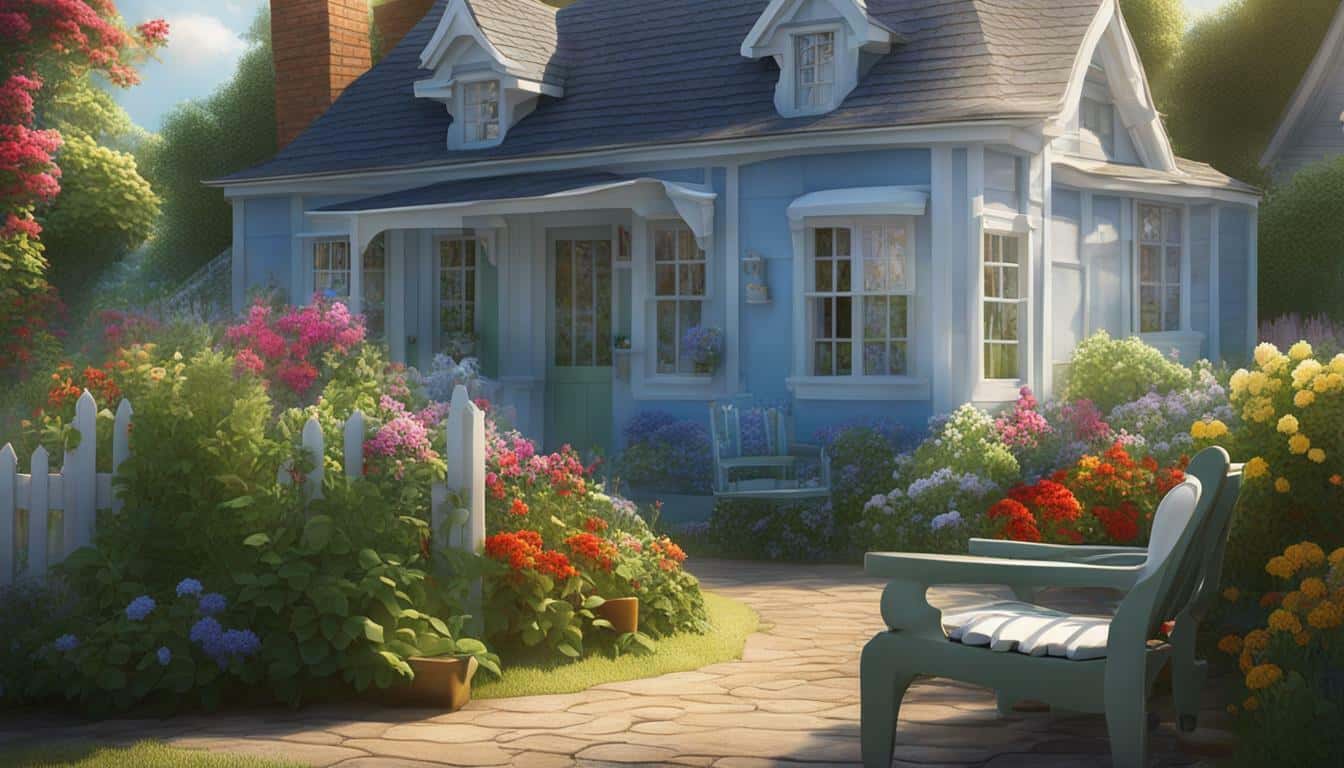



Leave a Reply